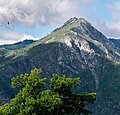Wedge Mountain (Washington)
| Wedge Mountain | |
|---|---|
 North aspect | |
| Highest point | |
| Elevation | 5,860 ft (1,786 m)[1] |
| Prominence | 160 ft (49 m)[2] |
| Parent peak | Three Musketeers Ridge[3] |
| Isolation | 2.35 mi (3.78 km)[3] |
| Coordinates | 47°30′57″N 120°42′24″W / 47.5157576°N 120.7067823°W[1] |
| Geography | |
| Country | United States |
| State | Washington |
| County | Chelan |
| Protected area | Alpine Lakes Wilderness |
| Parent range | Stuart Range Wenatchee Mountains Cascade Range |
| Topo map | USGS Leavenworth |
| Geology | |
| Type of rock | granite |
| Climbing | |
| Easiest route | scrambling |
Wedge Mountain is a 5,860-foot-elevation (1,786-meter)
Peak 6885
Mountain climbers and
Climate
Geology
The Alpine Lakes Wilderness features some of the most rugged topography in the
Geological events occurring many years ago created the diverse topography and drastic elevation changes over the Cascade Range leading to the various climate differences.The history of the formation of the Cascade Mountains dates back millions of years ago to the late
During the Pleistocene period dating back over two million years ago, glaciation advancing and retreating repeatedly scoured the landscape leaving deposits of rock debris.[7] The last glacial retreat in the Alpine Lakes area began about 14,000 years ago and was north of the Canada–US border by 10,000 years ago.[7] The U-shaped cross section of the river valleys is a result of that recent glaciation. Uplift and faulting in combination with glaciation have been the dominant processes which have created the tall peaks and deep valleys of the Alpine Lakes Wilderness area.
See also
Gallery
-
Wedge Mountain, with Peak 6885 seen to the right in back
-
North slope of Wedge Mountain from Leavenworth
References
- ^ a b c d "Wedge Mountain". Geographic Names Information System. United States Geological Survey, United States Department of the Interior. Retrieved 2022-04-22.
- ^ "Wedge Mountain, Washington". Peakbagger.com.
- ^ a b "Wedge Mountain - 5,860' WA". listsofjohn.com. Retrieved 2022-04-22.
- ^ a b c Beckey, Fred W. Cascade Alpine Guide, Climbing and High Routes. Seattle, WA: Mountaineers Books, 2008.
- ^ "South Wedge Mountain, Washington". Peakbagger.com.
- ^ Smoot, Jeff (2004). Backpacking Washington's Alpine Lakes Wilderness. Helena, Montana: The Globe Pequot Press.
- ^ a b c d e Kruckeberg, Arthur (1991). The Natural History of Puget Sound Country. University of Washington Press.
External links
- Weather: Wedge Mountain
- Wedge Mountain (Peak 6885): The Mountaineers




